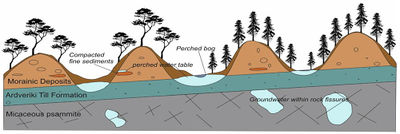OR/17/014 Evaluation of chosen field sites
| Archer, N A L, Everest, J. 2017. Final Report: Emergent Forest dynamics and Natural Flood Management. British Geological Survey Internal Report, OR/17/014. |
To install soil moisture sensors and measure soil permeability within a mature plantation and Old Forest in the Rothiemurchus estate, two site areas, Old Forest and Plantation, were chosen (shown in Figure 7) for the following reasons:
- They are located on the same psammite micaceous bedrock and moraine system.
- The two forests are adjacent, although there is a mire between them.
- The sites are 380 m apart and there is 15 m difference in altitude between sites. These relatively small differences will ensure similar weather conditions throughout the year.
- Both sites are situated downslope below moraine crests, above the break of the slope and are easily accessible.
The plantation area had been drained before planting in 1971. Saplings were planted on the tops of ridges and furrows to allow free drainage. It is still possible to see the ridging and furrows within the plantation as explained later in (Saturated hydraulic conductivity within adjacent old forest and plantation forests). The area is not fenced today and deer are able to roam through this forest area. It is expected that the plantation will be cut down within the next year.
In the Old Forest site, there is a seepage area at the lowest point, within a depression surrounded by trees, which was observed to stop flowing during dry intervals. Five metres below this point was a permanent spring. In the plantation site there were no continuous springs.
The Old Forest area is within the Rothiemurchus Estate Pinewood area, and the trees within the chosen study area are dated from 1750. The woodlands of Rothiemurchus have been managed for centuries for grazing, deer stalking, timber production and nature conservation. According to Piers Voysey, (the estate forester since 2010) during the 1800s tree felling and commercial planting were dominant landuses; later there was a pulse of forest regeneration and deer stalking, but by the 1980s overgrazing persisted due to high deer numbers (pers com., 2016). Today the forest is regenerating, due to the control of deer populations and the important conservation significance of the Rothiemurchus forest area that is recognised as a Site of Special Scientific Interest (SSSI) and is part of the Cairngorm National Park and Natura 2000 designations.
The wider area between these two sites
To understand the topographical situation between the two sites (in answer to the conceptual model in Figure 1), the relationship of moraine positions in terms of tree and peat depth distributions within the Old Forest and the adjacent plantation, were studied by:
- An aerial and field survey investigation to understand the relationship of moraine positions and tree distribution in the Old Forest and adjacent plantation.
- A field survey of peat depth within the Old Forest and adjacent plantation.
To characterise the moraine system, a simple set of morphological types were chosen to best reflect the overall shape of the landscape. The area has a dominant topographical elevation, i.e. the moraines overlay a dominant valley slope, which increases from the valley bottom towards the mountain slopes. The topographical positions were categorized into four groups:
- Upslope: the moraine slope facing upslope towards the higher dominant elevation
- Downslope: the moraine slope facing downslope towards the lower dominant elevation
- Depression: considered to be <2 degree slope angle; delineated from the break in the moraine slope (downslope) to the break in the opposite slope (upslope).
- Crest: considered to be <2 degree slope angle; delineated by the change of the moraine slope at its higher elevation.
The locations of these four categories are shown in Figure 6.
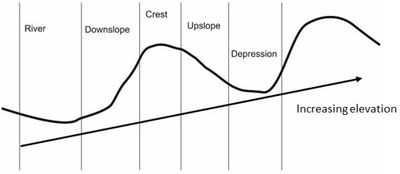
Topographic study and field survey of Scots pine distribution and moraine system in the plantation area
Studying aerial photographs with a DTM was not possible in the plantation because the canopy was so dense that the Digital Terrain Model (DTM) included tree heights, because the LiDAR signal could not penetrate through the canopy to the ground. Using a dGPS was problematic within the plantation, because the dense plantation canopy prevented accurate signals to estimate elevation. The accuracy of the dGPS heights was ±0.6 m for the few points that could be obtained under the plantation canopy.
To have an overall understanding of the moraine system within the plantation, stereo aerial photography and SOCET SET software were therefore used to determine differences of elevation within the plantation. This enabled the moraine system to be digitised, within the area surrounding the two sites (shown in Figure 7). It was difficult to digitize the smaller moraine mounds, as tree canopy sometimes became confused with the micro topography. However, Figure 7 shows the complexity of the terrain, where crests and depressions of the moraine system are defined, showing the landform patterns of the rising and falling micro topography and where streams develop in moraine depressions. Investigating the overall, area, also provides an understanding of dominant direction of water flow, for each chosen site (Shown as arrows in Figure 7).
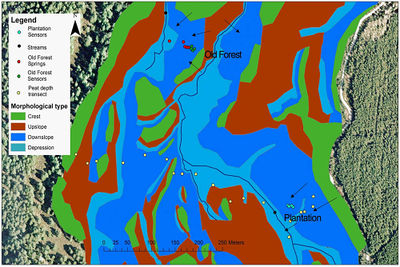
A field survey within the plantation suggested that the majority of wind-blown trees (trees that have been blown over) occurred in wet moraine depressions (figure 8), creating open gaps within the plantation canopy.
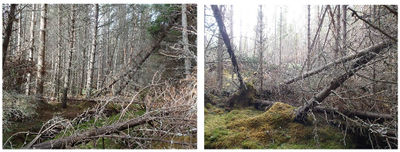
Aerial survey of tree distributions in the old forest to understand patterning of tree distribution
Methodology to classify terrain morphology
Aerial photography of the Rothiemurchus Pinewood area showed patterns of mature trees aligning along moraine crests and being absent in boggy areas. Therefore mapping of morphology was carried out using ArcGIS, using a combination of a 5 m resolution DTM and five transects were chosen based on clearly identifiable examples of the main morphological features being studied. The transects themselves were of varying lengths, most starting at the upslope end with the transition from bedrock to deposit-covered terrain, and ending with a significant change in morphological character, normally a large river channel. Each transect was buffered to 50 m, giving a 100 m-wide swathe of study area, and points were used to locate each tree top in the old forest on the aerial photos (Figure 9).
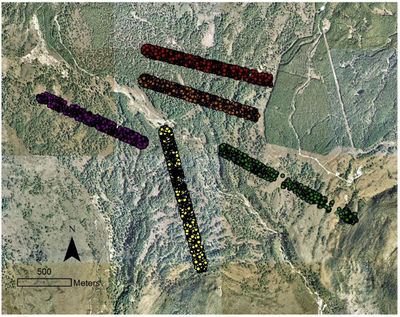
Using a combination of digital slope model (DSM) and aerial photographs, lines were mapped on each transect at distinct breaks in slope, both at moarine base and crest. In many cases this was straightforward as breaks were clearly visible on either or both the photography and DSM hillshade models (Figure 10). The topography was catergorised in the following way:
| Upslope | (Tn-UP): the moraine slope facing upslope towards the higher dominant elevation |
| Downslope | (Tn-DO): the moraine slope facing downslope towards the lower dominant elevation |
| Depression | (Tn-DE): considered to be almost <2 degree slope angle; delineated from the break in the moraine slope (downslope) to the break in the opposite slope (upslope) |
| Crest | (Tn-CR): considered to be <2 degree slope angle; delineated by the change of the moraine slope at its highest elevation. |
| River | (Tn-RI): The area which coincides to river banks and the river |
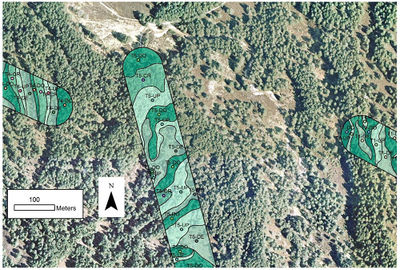
Within each transect the tops of trees were located using aerial photography. Each tree was located by adding a point in Arc GIS (shown in Figure 9) within each transect. The areas for the morphological types for each transect were estimated and the number of trees were counted to provide tree densities for each morphological type in units per m2.
Results of Scots pine distribution and moraine location
The results of Old Forest tree densities in relation to morphological areas are shown in Figure 11. Using the Anderson-Darling test, tree densities from all five transects were not significantly different from a normal distribution and therefore Analysis of variance (ANOVA) was used to test for significant differences of tree densities between the different moraine positions. Overall there was no significant difference (p = 0.075) comparing all four positions (crest, depression, downslope and upslope), but the Fisher Method, which compared the tree density means of each of the moraine positions, showed that the mean tree densities were significantly less (p < 0.05) in the moraine depressions than on moraine crests and slopes.
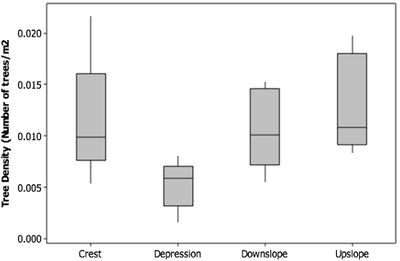
Measuring peat depths within Old forest and 40 year old plantation
The peat depth survey (shown as yellow dots in Figure 7) was undertaken to understand the relationship of the moraine landscape and peat depth in the both the Old Forest and the forty year old plantation.
Methodology to measure peat depth
A 400 m transect was surveyed by taking measurements on the crest, slope and depressions of moraines within the 40 year old plantation and ~300 year Old forest. An avalanche probe was used to probe through the peat (as shown in Figure 12) and when it stopped at a hard surface the depth of the probe was noted. Five points were measured at each location.
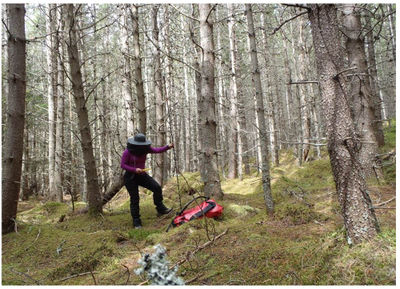
Results of peat depths measured in old forest and 40 year old plantation
Peat depth was found to be highly significantly deeper (p = 0.001) in the Old forest area than the 40 year old plantation and highly significantly deeper (p = 0.001) in moraine depressions. These relationships are shown in Figure 13.
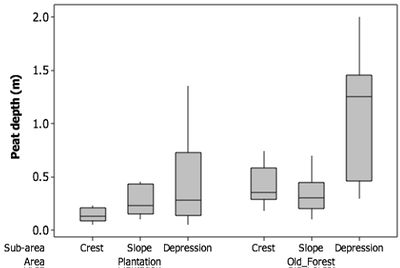
Discussion of wider extent of the Old Forest and adjacent plantation
Following the wider survey of tree and moraine distribution, the conceptual model in Figure 1 was redrawn to take into account the better understanding of geology, peat depth and forest location.
The re-conceptualised model shows the significantly deeper depths of peat in the moraine depressions, with thinner layers of peat on moraine crests, with peat being deeper in depressions under the older forest (Figure 13). The Older trees in the Rothiemuchus estate are positioned mainly on moraine crests and slopes (Figure 11) and the trees in the plantation are positioned regardless of moraine topography, although there tends to be a greater number of fallen trees in the moraine depressions (Figure 7).
Following the superficial geology stratigraphy shown in the Aviemore Superficial geology map (Sheet 74E[note 1]), the Ardveriki Till Formation is below the Morainic Deposit. The morainic deposits consist of poorly sorted gravel, sand and sandy diamicton forming boulder-strewn mounds. The Ardveriki Till formation is mainly diamicton, silty clayey, sandy and gravelly till, mainly a pale yellowish brown with clasts of micaceous-psammite with some granodiorite, porphyry and granite. The presence of till will create perched water tables, as the permeable morainic deposits overlie the less permeable till. Some of the moraine depressions are also likely to have fine sediments under the peat, which developed after glacial retreat, when ponding and slowing of water formed in the moraine depressions, depositing fine clays and silts. Such processes are explained by Benn and Evans, 1998, p.489[note 2]. Peat later developed on top of these more impermeable lake deposits.
The extent of impermeable layers are unknown, but they exist in many of the moraine layers in the Cairngorms and can be seen in some of the undercut moraines near to this site. These are included in Figure 7, showing the location of harder impermeable layers, creating multiple perched water tables. Because of the complexity of the Glacial fluvial geology in the Cairngorms, more investigation is needed to quantify how these perched water tables exist and are distributed across the Cairngorms.
